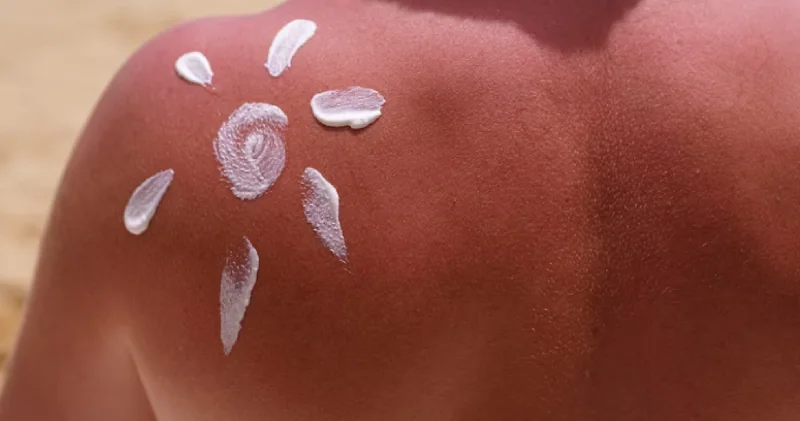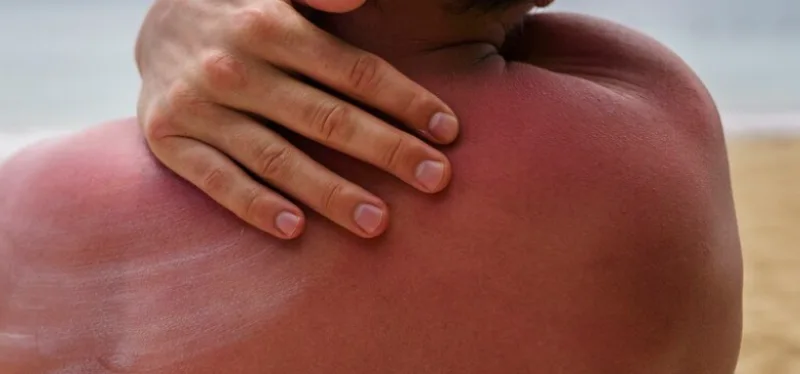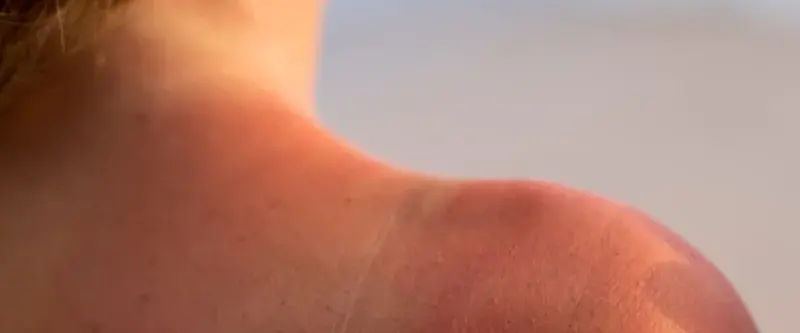A sunburn can cause long-term skin damage, including cancer and premature aging. Cycling without proper sun protection exposes cyclists to an increased risk of skin cancer, primarily melanoma, the deadliest form.
A good way to prevent skin cancer after a bad sunburn while cycling is to ensure that it does not recur. You should incorporate sunscreen into your morning routine to make it a daily habit.
Use wide-brim hats, sunglasses, and clothing with UV protection. UVA and UVB protective sunscreen with an SPF of 30-50 should be applied and reapplied.
This post will discuss some best practice prevention tips for helping cyclists prevent skin cancer after a sunburn.
How To Prevent Skin Cancer After A Bad Sunburn For Cycling: 12 Ways

Cycling is an exhilarating and healthy outdoor activity, but it comes with the risk of sun exposure. A bad sunburn is not just a temporary discomfort, it can significantly increase your risk of developing skin cancer. Here are various preventive measures to help cyclists minimize the risk of skin cancer after experiencing a bad sunburn:
Daily Sunscreen Use
It is essential to protect your skin from UV damage by using sunscreen daily. Even on cloudy days, up to 80% of the sun’s rays can penetrate the clouds to reach your skin.
- Choose the Right Sunscreen: Opt for an SPF 30 or greater that offers UVA and UVB protection. Ensure it has at least SPF 15, although SPF 30 or higher is recommended for prolonged outdoor activities like cycling.
- Incorporate into Your Routine: Make applying sunscreen a daily routine, like brushing your teeth. This habit ensures you’re always protected, even when you don’t plan to be outside for long.
Broad-Spectrum Protection
A broad-spectrum sunscreen blocks UVA and UVB rays. Sunlight damages the skin by causing premature aging and skin cancer, while UVB rays cause sunburns and play a role in causing skin cancer as well.
- Comprehensive Coverage: Broad-spectrum sunscreens offer comprehensive protection, reducing sunburn risks and long-term damage to the skin.
- Enhanced Formula: Many broad-spectrum sunscreens are planned to be water-resistant and sweat-resistant, making them ideal for cyclists.
Generous Application
Applying sunscreen generously is crucial for adequate protection. Many people apply too little, significantly reducing the sunscreen’s effectiveness.
- Use Enough Product: Most adults need about one ounce (a shot glass full) to cover their entire body. Don’t skimp on the amount.
- Cover all Areas: Apply sunscreen to all exposed areas, including less obvious spots like the ears, scalp (if you have thinning hair), neck, hands, and the tops of your feet.
- Get Help if Needed: If you have trouble reaching certain areas, such as your back, ask someone for help or use a spray sunscreen.
Regular Reapplication
Sunscreen must be reapplied regularly to maintain effectiveness, especially if you’re sweating or swimming.
- Every Two Hours: Reapply sunscreen every two hours or more frequently if you’re sweating heavily or swimming.
- After Towel Drying: If you’ve wiped your skin with a towel, reapply sunscreen immediately, as towel drying can remove the protective layer.
Avoid Peak Sun Hours

UV radiation is most substantial between 11 a.m. and 4 p.m. Limiting sun exposure between these hours can significantly reduce your risk of sunburn and skin cancer.
- Plan Your Rides:Schedule your cycling sessions in the early morning or late afternoon when the sun’s rays are less intense.
- Use Sun Protection: If you must ride during peak hours, take extra precautions like wearing sun-protective clothing and applying a high-SPF sunscreen.
Sun-Protective Clothing
Wearing sun-protective clothing is an excellent way to shield your skin from harmful UV rays. Modern fabrics are lightweight, breathable, and offer excellent UV protection.
- Long-Sleeved Jerseys and Pants: Opt for long-sleeved jerseys and full-length cycling pants made from UV-protective fabrics.
- Wide-Brimmed Hats and Visors: A wide-brimmed hat or a visor attached to your helmet can provide additional protection for your face and neck.
- Sunglasses: To protect your eyes and the delicate skin around them, wear sunglasses that block 100% of UVA and UVB rays.
Seek Shade
Take breaks in shaded areas to minimize your sun exposure. Shade can provide significant protection from direct UV rays.
- Plan Rest Stops: Identify shaded areas along your route where you can take breaks. This will help reduce your cumulative sun exposure.
- Portable Shade: Consider carrying a lightweight, portable shade like an umbrella or a pop-up tent if you’re going on a long ride.
Monitor Skin Changes
Checking your skin regularly for changes can help you catch potential skin cancer early when it’s most treatable.
- Self-Exams: Conduct a thorough self-exam once a month. Use a mirror to check hard-to-see areas or ask someone to help you.
- Look for Warning Signs: Pay attention to new moles, changes in old moles, or other unusual skin changes. The ABCDE rule can help with asymmetry, Border irregularity, Color changes, Diameter over 6mm, and developing shape or size.
Annual Skin Exams
An annual visit to the dermatologist for a thorough examination is essential for early skin cancer detection.
- Comprehensive Check: A dermatologist will examine your entire body, including areas not typically sun exposure.
- Follow-Up: If any suspicious areas are found, your dermatologist may recommend a biopsy or other follow-up procedures to determine if further action is needed.
Topical Retinoids
Topical retinoids, derived from vitamin A, are effective in promoting skin cell turnover and can help repair sun-damaged skin.
- Cell Turnover: Retinoids increase the rate at which your skin cells turnover, helping to remove old, damaged cells and encourage the growth of fresh, healthy cells.
- Reduce Fine Lines and Wrinkles: Regular application of retinoids can also reduce lines and wrinkles, mainly when there’s sun damage.
Know Your Skin Type

You should understand your skin type before choosing sun protection and treatment products. Different skin types have varying sensitivities to the sun and can react differently to sunburn and treatments.
- Fitzpatrick Scale: The Fitzpatrick scale classifies skin types from I (very fair) to VI (very dark). Knowing your classification can help you take precautions.
- Customized Protection: Fair-skinned individuals (Types I and II) are more prone to sunburn and need higher SPF protection. Darker-skinned individuals (Types V and VI) still need sun protection but may not burn as quickly.
Recognize Warning Signs
Skin cancer can be detected early and saved. To improve your chances of success, it is essential to recognize warning signs and seek medical attention promptly.
- New Growths or Sores: A dermatologist should evaluate any new growths, sores that don’t heal, or changes in existing moles.
- Persistent Itching or Bleeding: Persistent itching, tenderness, or bleeding in a skin lesion can be a sign of skin cancer.
- Changes in Sensation: Any changes in sensation, such as pain or tenderness in a mole or growth, should be checked.
Conclusion
Preventing skin cancer after a lousy sunburn requires a multi-faceted approach. You can significantly reduce your risk by incorporating daily sunscreen use, choosing broad-spectrum protection, applying sunscreen generously, and reapplying it regularly.
Additional measures that provide excellent protection are avoiding peak sun hours, wearing sun-protective clothing, and seeking shade. Regularly monitoring your skin for changes and scheduling annual skin exams with a dermatologist is crucial for early detection and treatment.
FAQs
Can You Reverse Sun Damage To Prevent Skin Cancer?
Some treatments can help with collagen production, skin turnover, improvement in the appearance of dark spots, etc. Although sun damage cannot be completely reversed.


